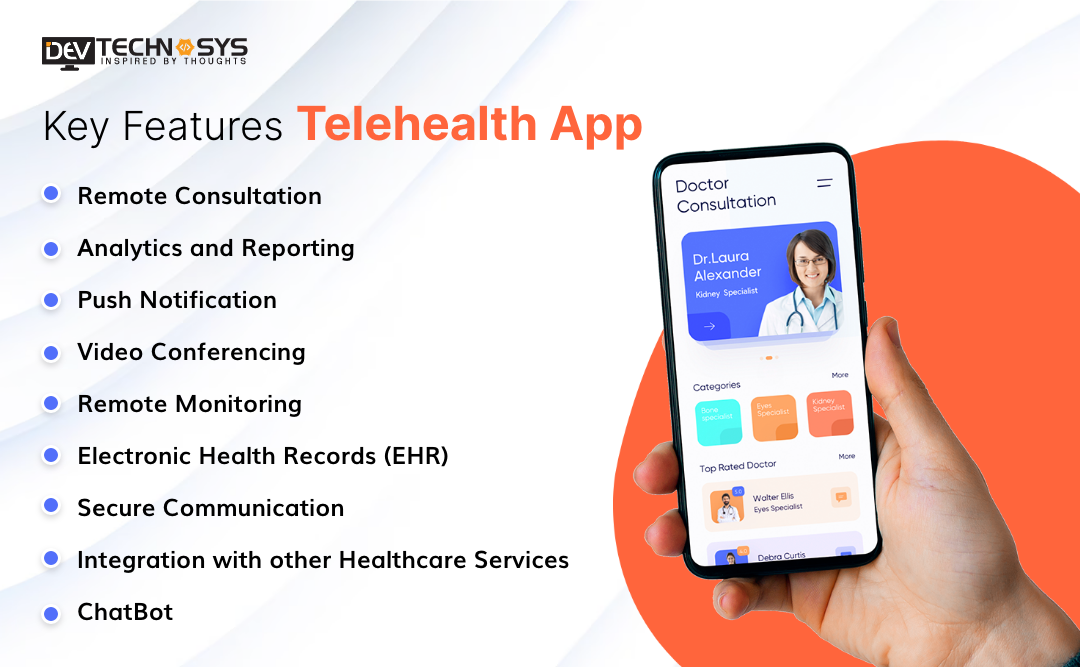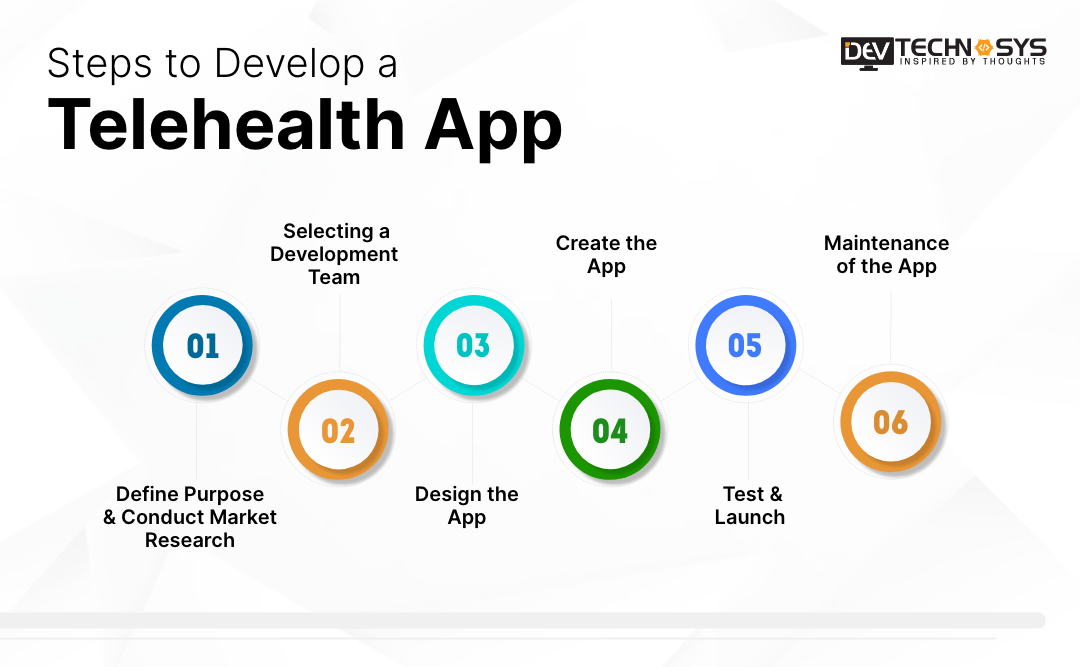Welcome to the future of healthcare!
In today’s rapidly changing world, telehealth app development has emerged as a game-changer in the healthcare industry. With the advent of new technologies, healthcare access is rapidly evolving. Telehealth app development is one of the most exciting innovations, offering a convenient and affordable way for patients to connect with healthcare providers from the comfort of their homes.
This technology has opened up a new world of possibilities, allowing people to receive high-quality medical care regardless of location or time constraints. But, in this telehealth technology tutorial, we will explore the world of telehealth technology, discussing what it is, how it works, and the features it offers to patients and healthcare providers alike.
So, get ready to step into the future of healthcare with us and learn how telehealth technology is transforming how we access medical care.
What is Telehealth Technology?
The use of communication and information technologies to deliver remote healthcare services and medical consultations is called telehealth technology, also known as telemedicine. It covers a range of digital platforms that let healthcare providers communicate with patients and perform healthcare services remotely, including video conferencing, mobile health apps, remote monitoring devices, and secure messaging systems.
Furthermore, several health concerns can be identified, treated, and managed with telehealth technology, including acute illnesses, mental health issues, and chronic diseases. So, without traveling to a physical healthcare institution, it enables patients to obtain medical care conveniently from their homes or other remote locations.
Telehealth Technology: How It Works
In this telehealth technology tutorial, we tried to compile the working of telehealth applications that enhance mobile apps’ role in the healthcare industry.
Read carefully to understand more.
Thanks to telehealth technology, patients can get medical care remotely via digital tools like computers, tablets, and cell phones. Patients can contact healthcare professionals using safe online services or mobile apps, get prescriptions filled, obtain medical advice, and even get diagnoses and treatments. However, videoconferencing, remote patient monitoring, and virtual visits are examples of telehealth technologies. So, healthcare professionals can confer with patients in real time, and patients can receive treatment at home. So, without the need for in-person visits, this technology provides patients with a practical and handy approach to monitoring their health and obtaining healthcare services.
Key Features Telehealth App
Telehealth apps are designed to provide remote medical care to patients, enabling them to receive virtual medical consultations from healthcare providers. But, the key features of telehealth apps include the following:

1. Remote Consultation:
Remote consultations with patients are possible thanks to telehealth. But, it enables patients to obtain medical guidance and care without leaving their homes, which can be especially useful for those with mobility challenges or who reside in rural or distant places.
2. Analytics and Reporting:
Telehealth apps should provide healthcare providers with analytics and reporting features that enable them to track their patient’s health progress over time. So, this feature should also help healthcare providers to identify areas for improvement in their telehealth services.
3. Push Notification
Users can utilize the feature to receive a notification before the scheduled cancellation that serves as a reminder. So, you must know that it is the most useful element in any mobile app development service because it sends notifications to the user’s phone for every activity and action.
4. Video Conferencing:
With video conferencing, healthcare professionals can interact with patients face-to-face virtually, simulating an in-person visit. But, professionals in the mental health field would benefit from this capability because they can conduct therapy sessions via video conferencing. So, hire one of the best hybrid app development companies to create complete telehealth applications.
4. Remote Monitoring:
Wearable technology and other monitoring technologies can easily enhance telehealth applications, enabling medical professionals to monitor patients’ health problems from a distance. But, is crucial to know that it enables medical professionals to monitor patient development and modify treatment regimens as necessary.
5. Electronic Health Records (EHR):
Thanks to electronic health records, healthcare professionals may access individuals’ medical histories, including lab results, prescriptions, and treatment plans. But, it can aid healthcare professionals in making better choices regarding patient care. So, therefore, electronic health records are one of the functions or advanced technologies that can make healthcare apps more interactive.
6. Secure Communication:
Telehealth platforms must be built with strong security measures to protect patient privacy and adhere to pertinent laws like HIPAA. So learn that it includes secure communications, encryption, and other features to safeguard patient data.
7. Integration with other Healthcare Services:
To give patients an excellent healthcare experience, telehealth should be able to interface with other medical services, including pharmacy, laboratory, and radiology services.
8. ChatBot:
Chatbots In Healthcare Industry can assist patients in answering common questions, scheduling appointments, and providing basic medical information, improving the accessibility and efficiency of healthcare services.
The Difference Between Telemedicine and Telehealth
We have almost got you covered on the telehealth technology tutorial. However, now is when you must dive into the aspect to know the difference between telemedicine and telehealth. However, the phrases telemedicine and telehealth are closely related and frequently used interchangeably, they represent different things. So, the following are some crucial distinctions between telehealth and telemedicine:
Basis |
Telemedicine |
Telehealth |
Scope |
Telemedicine refers specifically to the use of electronic communication and information technologies to provide clinical health care services from a distance. |
Telehealth, on the other hand, is a broader term that encompasses a wide range of remote healthcare services, including clinical care, health education, public health interventions, and more. |
Applications |
Telemedicine is most commonly used for remote diagnosis, consultation, and treatment of specific medical conditions. So, this includes virtual visits with healthcare providers, remote monitoring of patients, and sharing of medical records and diagnostic images |
Telehealth, on the other hand, can be used for a wider range of applications, including health promotion and disease prevention, patient education and engagement, and public health initiatives. |
Providers |
Telemedicine services are typically provided by licensed healthcare professionals, such as physicians, nurses, and mental health providers. |
Telehealth services, on the other hand, can be provided by a wider range of professionals, including community health workers, health educators, and public health officials. |
Settings |
Telemedicine services are typically provided in clinical settings, such as hospitals, clinics, and private medical offices. |
Telehealth services can be provided in a variety of settings, including schools, community centers, workplaces, and homes. |
Technology |
Telemedicine relies on electronic communication and information technologies to deliver health care services. But, it typically requires more specialized equipment and software to support clinical diagnosis and treatment, such as high-resolution cameras, remote monitoring devices, and secure electronic medical records |
Telehealth services may rely on more basic technologies, such as smartphones and web conferencing tools. In order to supply healthcare services, electronic communication, and information technologies are also used. |
In conclusion, telehealth technology tutorials provide knowledge of everything about telehealth technology. Telehealth app is a more general word that encompasses a larger range of remote health care services beyond clinical care. So, in contrast, telemedicine explicitly refers to electronic communication and information technologies for distant clinical health care services.
How to Develop a Telehealth App?
Another chapter in the telehealth technology tutorial is development. But, developing a telehealth app involves several steps: planning, designing, developing, testing, and deploying the application. So, here are some key steps to the telehealth technology tutorial:

Step 1: Define Purpose & Conduct Market Research:
The main objectives of the app should be clear, such as video consultations, appointment scheduling, remote monitoring, and medication administration. However, research the market to find out what your intended audience wants from a telemedicine app. So, it is important to examine the applications of your rivals and their advantages and disadvantages.
Step 2: Selecting a Development Team
It is time to select an android app development service with knowledge of creating telehealth applications. But, they must know about creating web and mobile applications and security and data privacy. So, you should know that only an incredible healthcare software development company can provide you with effective healthcare app development.
Step 3: Design the App
Make an intuitive, user-friendly, and universally accessible user interface and experience. Therefore, make sure the app’s design is user-friendly, responsive, and cross-platform. So, you need to make a list of the ideal characteristics your telehealth application should have at this time.
Step 4: Create the App
The agile technique, which enables iterative development and quick feedback, should be used by your iOS app development company to create your software. But, to guarantee data privacy and security, they should also have features like authentication and encryption.
Step 5: Test & Launch
Test the app’s performance, security, and usability in-depth. Real users can test the app, gather feedback, and then iterate the app as necessary. But, deploy the software to the Google Play Market and the App Store once it has passed all the tests. So, to ensure the app reaches its intended audience, advertise it using digital marketing techniques.
Step 6: Maintenance of the App
Maintain and update the on-demand app development regularly to ensure it is compatible with the newest hardware and operating systems. But also, ensure all patient data is protected, and the app is kept secure.
Therefore, on-demand app development involves a thorough understanding of the medical field, user requirements, and technology potential. So, working with a team of professionals is essential to guarantee that the app is created appropriately, satisfies patient needs, and complies with all applicable laws.
How Much Does It Cost To Make Telehealth App?
The cost to make a telehealth app can vary depending on various factors such as the app’s complexity, the features required, the development platform, team size, and the location of healthcare software development services. But, here’s an estimated cost breakdown for developing a telehealth app:
|
Development Stage |
Cost Range |
|
Business Analysis |
$3,000 – $5,000 |
|
UI/UX Design |
$2,000 – $8,000 |
|
Front-end Development |
$3,000 – $6,000 |
|
Back-end Development |
$4,000 – $8,000 |
|
Telemedicine Features |
$3,000 – $7,000 |
|
Admin Panel Development |
$2,000 – $6,000 |
|
API Development and Integrations |
$1000 – $4,000 |
|
QA and Testing |
$3,000 – $9,000 |
|
Deployment and Launch |
$2,000 – $4,000 |
|
Maintenance and Updates |
$2,000 – $4,000 |
Certainly, the total telehealth app cost can range between $30,000 to $61,000, depending on the app’s requirements and features.
In a Nutshell!
Above all, hopefully, you liked this blog, and now you know effective telehealth technology tutorials. However, telehealth apps have revolutionized the healthcare industry by offering patients a convenient way to access healthcare services from the comfort of their homes. But, it is vital to know that telehealth apps have made healthcare services more accessible, efficient, and cost-effective, especially for those who live in remote areas, have mobility challenges, or have busy schedules. So, if you want to invest in LIMS Software Development, choose one of the great healthcare software development companies.
Frequently Asked Questions
1. How Long Does it Take To Build Healthcare Software?
The time it takes to Build Healthcare Software can vary depending on the complexity and features required. But, developing and launching a telehealth app can take anywhere from a few months to over a year.
2. How To Hire Dedicated App Developers?
To complete the telehealth technology tutorial, it is crucial to hire dedicated app developers. So, follow the steps below to learn about the cycle of hiring developers for a project.
- Define Your Project Requirements
- Determine Your Budget
- Search For Healthcare software development services
- Conduct Interviews,
- Check Portfolios And References,
- Assess Communication Skills.
- Welcome On Board
3. What Are The Types of Telehealth Apps?
If you want to develop a telehealth app, then knowing about its types is crucial. However, telehealth app development is divided into two categories which we have mentioned below.
- Synchronous Care
- Asynchronous Telehealth














